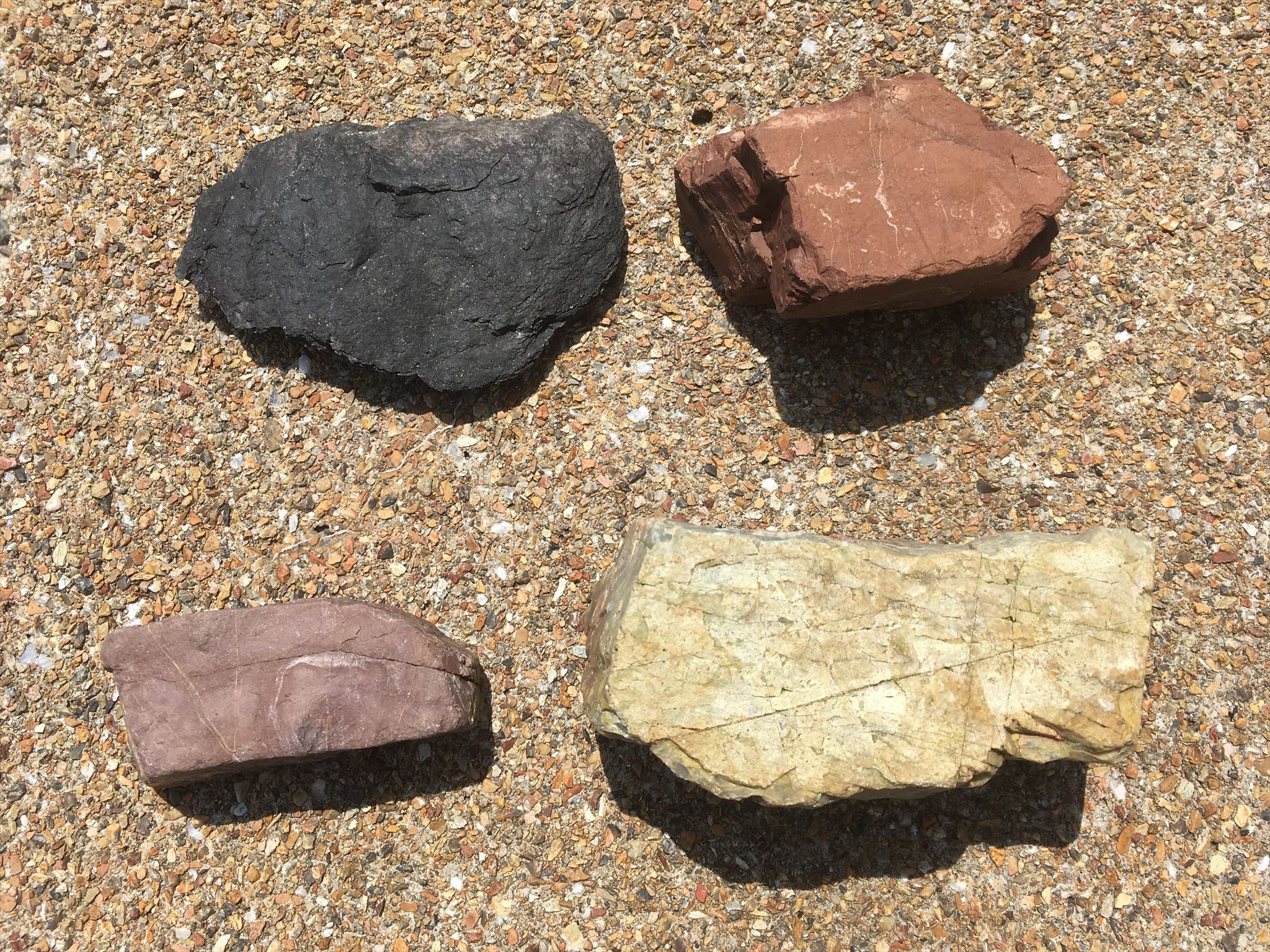注意事項 (Please note)
GZは海岸にあります。満潮時には近寄れない時がありますので、事前に潮位を確認ください。 (潮見表 )
GZ is on the coast. There are times when you can not get close at high tide, so check the tide level in advance.
この写真は国際宇宙ステーションから見た「マニクアガン・クレーター」(カナダ、ケベック州)です。大きさは直径100kmにも及ぶ巨大なもので、今から約2億1,500万年前に巨大隕石が衝突してできました。そしてこの時、衝突の影響により地球上の海洋生物は絶滅したのです。
この絶滅の痕跡は網代島近くの地層から見つかりました。そして網代島では、約2億5,000万年前に起きた史上最大級の生物大量絶滅の痕跡を目の当たりにすることができます。網代島周辺は絶滅痕跡が残された世界的に貴重な場所なのです。
This picture is the "Manicouagan Crater" (Quebec, Canada) seen from the International Space Station. This size is a huge 100km in diameter, and it was formed by the collision of huge meteorites about 215 million years ago.And at this time, the marine creatures on the earth were extinct due to the impact of the collision.
Traces of this extinction were found in the stratum near Ajirojima Island.And, at Ajirojima Island, we can see the traces of the mass extinction of organisms that occurred about 250 million years ago. The area around Ajirojima Island is a globally valuable place where traces of extinction are left.
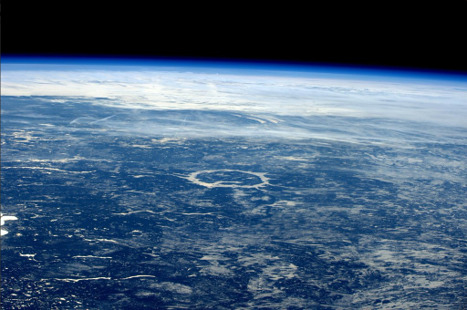
地球史上、生物絶滅は5回起きていることが分かっています。
下の図をご覧ください。これは古生代カンブリア紀(5億4,000万年前)以降の顕生代における「生物絶滅のビッグ5」を表したものです。注:顕生代とは「肉眼で見える生物が生息する時代」という意味です。
ビッグ5とは、①三葉虫等の絶滅、②原始魚類絶滅、③史上最大級の生物大量絶滅、④海洋生物絶滅、⑤恐竜絶滅のことです。
④・⑤は隕石衝突が原因ですが、①~③は原因がはっきりと分かっていません。
In the history of the earth, we know that biological extinction has occurred 5 times.
Please check the figure below. This represents the "Big 5 of extinction" in the Phanerozoic since the Paleozoic Cambrian (540 million years ago). Note: The Phanerozoic means "the age when living creatures that can be seen with the naked eye inhabit".
The Big 5 refers to,①the extinction of trilobite etc., ②primordial fish extinction, ③largest extinct organisms mass extinction in history, ④marine creatures extinct, and ⑤dinosaur extinction.
Although ④ and ⑤ are caused by meteor impact, but, ①~③ do not have a clear cause.
出典:「生物の科学遺伝 Vol.66 No.5」株式会社エヌ・ティー・エス
Source: "Science and genetics of organisms Vol.66 No.5" NTS Inc.
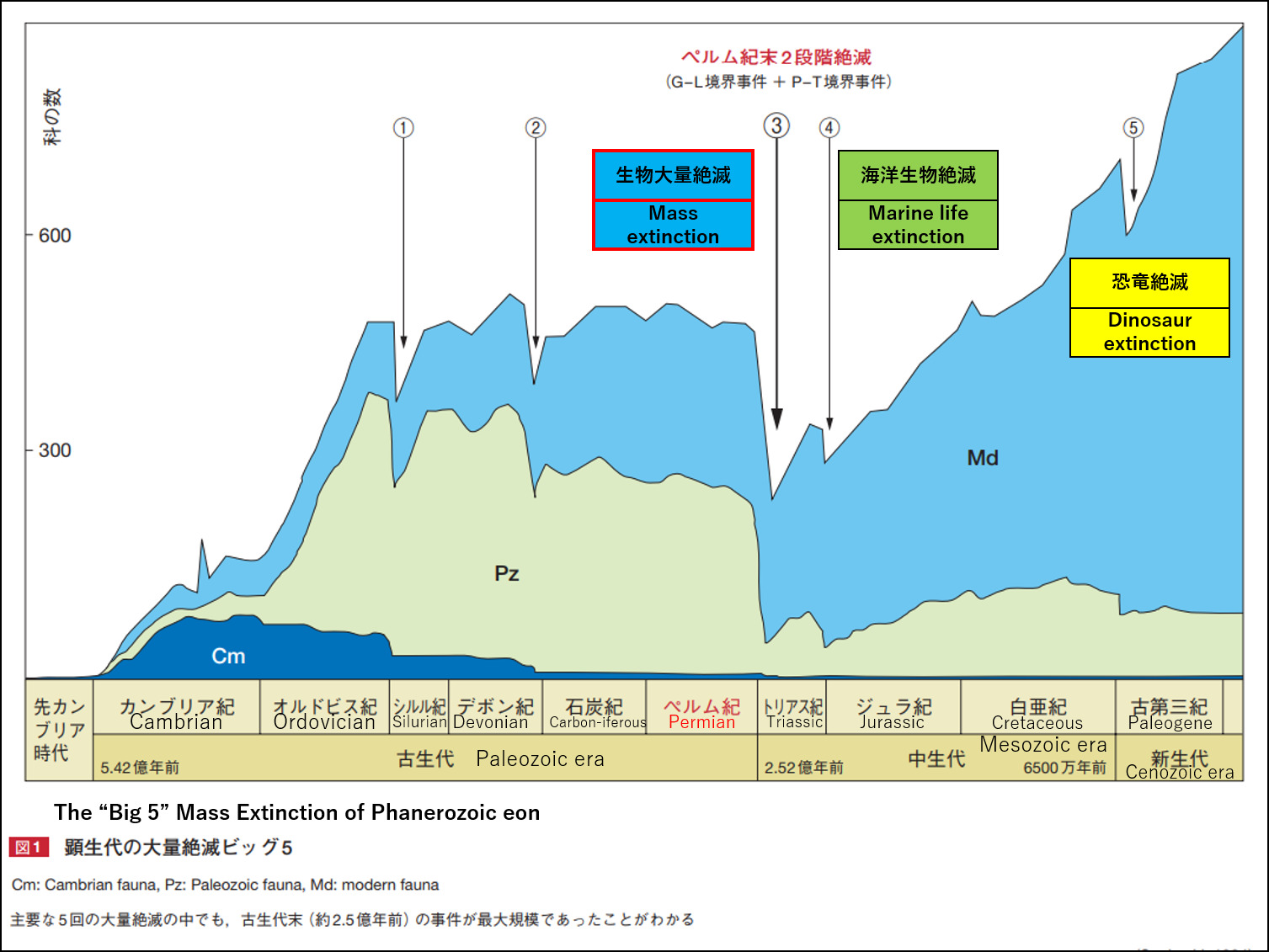
では、網代島とその周辺でどのような痕跡が見つかったのか調べてみましょう。
Let's examine what trace was found Ajirojima Island and around there.
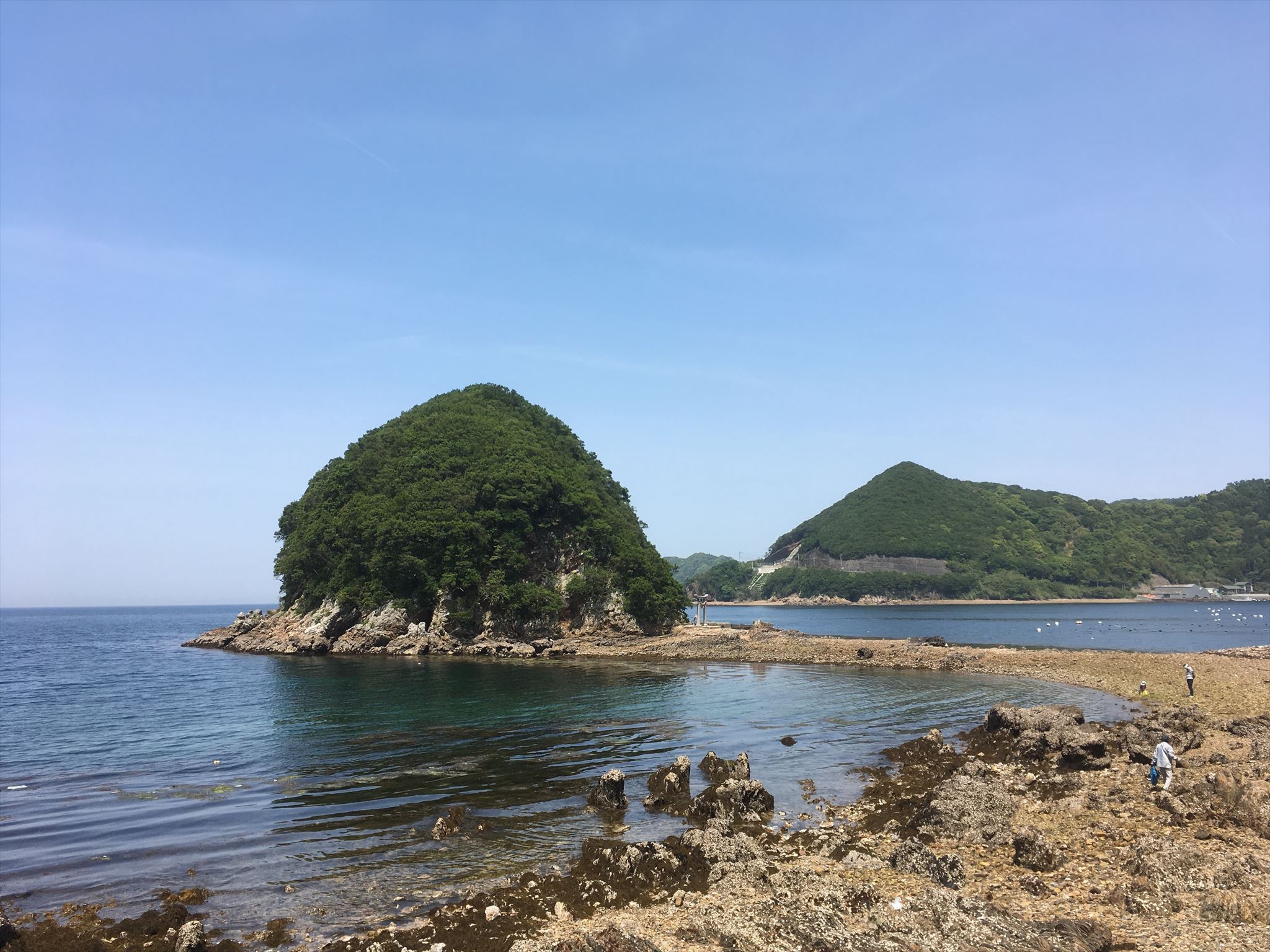
《③史上最大級の生物大量絶滅》
網代島では黒い頁岩と赤や紫、緑色の「チャート」を見ることができます。
黒い頁岩は生物大量絶滅の直ぐ後にできた地層です。海に空気(酸素)が非常に少ない環境の中でヘドロのような有機物や硫化鉄が堆積してできました。
チャートは放散虫と呼ばれる海の動物プランクトンが集まってできたものです。チャートができた「三畳紀」は、地球の歴史の中で最大の生物大量絶滅が起こったすぐあとの時代です。海に酸素が回復すると、海の中の鉄分と酸素が反応して鉄さび(酸化鉄)ができて赤色になります。このチャートの色の変化は、大昔の海に酸素が回復していった様子を記録しているといわれています。
《③The largest biological mass extinctions in history》
On Ajirojima island, we can refer to "black shale" and "red, purple and green cherts".
The black shale is a stratum formed immediately after the mass extinction of organisms. At that time there was very little air (oxygen) in the sea. Organic matter such as sludge, and iron sulfide were deposited to form a shale.
The chert is the result of the deposition of marine zooplankton called radiolaria.The "Triassic", where the chert was made, is the time immediately after the largest mass extinction of organisms in the history of the Earth.When oxygen recovers to the sea, iron in the chert and oxygen react to form iron rust (iron oxide) and become red.The color change on this chert is said to record how oxygen recovered to the ancient sea.
《④海洋生物絶滅》
2016年に網代島から1kmしか離れていない場所の網代島と同じチャートからマニクアガン・クレーターを作った隕石衝突の痕跡が見つかりました。(下図を参照ください)
三畳紀後期のチャートから、大きさ 1mm 以下の放散虫等の化石を調べたところ、隕石衝突直後に非常に高い割合でこれら化石群集が絶滅していることが分かりました。(研究は岐阜市で採取された試料で行われました)
《④Marine creatures extinction》
Traces of the meteor impact that made the Manicouagan Crater were found in 2016 at a distance of only 1 km from Ajirojima Island. (Please refer to the figure below)
Researchers examined fossils such as radiolarians with a size of 1 mm or less in the Late Triassic chert. Then, it turned out that these fossil assemblages are extinct at a very high rate immediately after the meteor impact. (Study was conducted on samples collected in Gifu City)
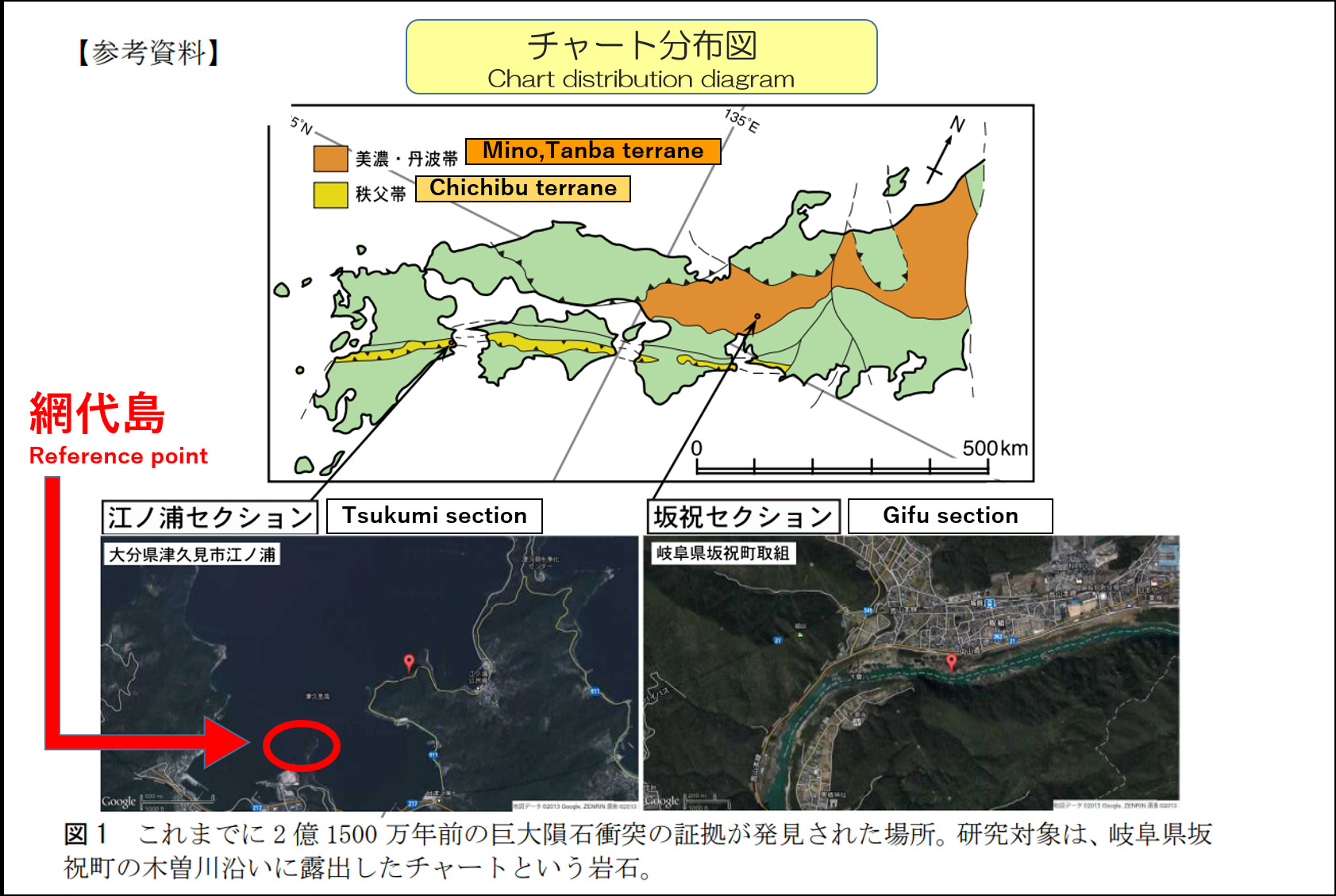
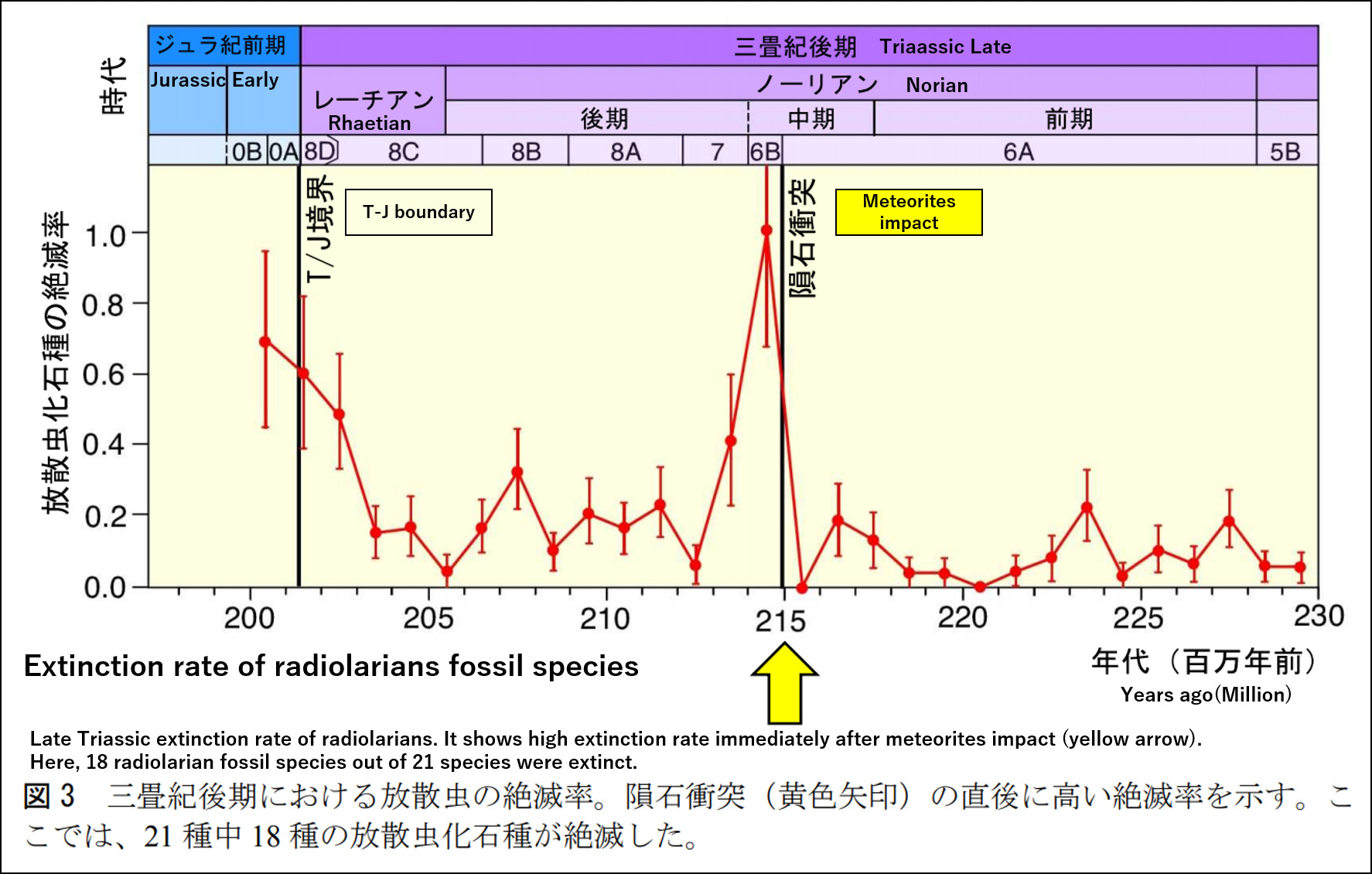
出典:「新聞発表資料」(2016.07.08) 熊本大学
Source: 「Press Release」(2016.07.08) Kumamoto University
1. 以下のTASKを実行してください。
2.キャッシュ名と解答をキャッシュオーナー(hikohohodemi)にメールしてください。
3. 答えはログに記入しないでください。
4.メールを送信したらファウンドログを上げてください。私の承認を待つ必要はありません。
1. Please carry out following TASK.
2. Please send e-mail this cache name and the answer to following questions to cache owner.(hikohohodemi)
3. Do not include this answer in your on-line log.
4. You do not need to wait for confirmation from me before posting online.
TASK 1
4つの岩を年代が古い順に並べてください。A.赤いチャート、B.緑のチャート、C.紫のチャート、D.黒い頁岩
例)A,B,C,D
Please Arrange the four rocks correctly in chronological order. A. Red Chert, B. Green Chert, C. Purple Chert, D. Black Shale
Ex) A,B,C,D
TASK 2
黒い頁岩にはプランクトンが含まれていません。何故でしょうか?
あなたの考えを述べてください。
The black shale contains no plankton.
Why is that? Please explain your thoughts.
OPTION
海岸で4色の岩の破片を集めて写真を撮り、ログにアップロードしてください。
Please collect 4 colored rocks fragments at the shore, take a picture of these and upload it to the log.
